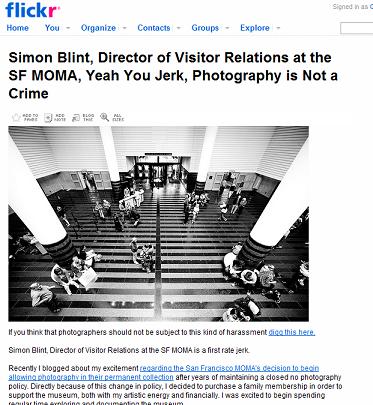Photo, film and the security divide
I’ve been looking around the net, and there’s any number of accounts from photographers who feel hassled, harrassed, bullied, battered, wronged, insulted and generally shittily treated (sorry about that adverb) by police, security, army, navy, proprietors of select stores, owners of select property and whatever else might be construed as some sort of authority figure, just for taking pictures.
[ad name=”in-post”]
I agree. It happens. Not everyone likes having pictures taken of their person and/or property. Not everyone wants publicity, exposure or any kind of relationship with either public or private parties, who might see them in the photos or film. So it happens. Sometimes the photographer is in the right, sometimes the security people (I’ll stick with those since that’s kinda this site’s theme, ain’t it) are in the wrong, and sometimes it’s just the other way around.
Now, taking pictures IS NOT A CRIME! It’s not. In public places, you can (in most countries) take pictures or film anything that is visible to you. WITH SOME EXCEPTIONS! If you, for example, take a picture of a person, and you intend to use that picture for direct personal gain (for example, you intend to sell the image to a commercial campaign), you need the subject’s OK. I.e. you need a “model release”, and in many cases a contract, and the subject usually is entitled to some kind of compensation. Now, taking pictures for your project on architecture, for example, is a bit different. Buildings in public places can be private property (usually is, in fact) and you’ll in many cases need special permission to shoot INSIDE them. The outside, however, from a public place, is fair game. ALWAYS.
Take a peek at this guy. Thomas Hawk’s Flickr profile says a lot, and some of the photos in his stream say even more. He is a guy who firmly stands on his rights as a photographer, and several run-ins with security, police and proprietors can’t get him to back down. This is in general a good thing – citizens should be able to move around and act according to their rights without fear of being hindered or arrested without cause.
However…(and you just knew there was a “however”, didn’t you?) there are, seemingly, some photographers out there who are more prone to getting into these situations than others. Thomas Hawk is one of them. Here’s why (or maybe why).

Being overly aggressive in encounters with individuals in authority (where you have less such than them, that is) is never a good idea. If you need to go into some sort of confrontation or discussion, make sure you have thee rights on your side, and make sure you’re the “bigger man” (or woman) and BE CIVIL! Never, ever be aggressive with security officers or police or other authority figures. If you are, then you’ve automatically lost.
Being, at times, overly aggressive myself, I know that if I take that route when I’m not on my own turf, that’s a very unsure gamble, and might blow shrapnel in my face at any moment. Sometimes I win, yes, but not at all always.
I had a visitor to my place of work today, and this female had a bit of a ” ‘tude” towards me. After being told that if she held her mouth closed, did what she was told and dropped the tude, everyone could happily go about their business, she turned to me and asked me right out who was going to win this. I told her in two words; “I am.”
Unless you can positively tell someone that in those two words, you should hold your temper on very short reins.
[ad name=”in-post”]
Now, photographers will chase that perfect angle, that perfect lighting, that all important “moment” (in itself a very much discussed and disagreed-upon subject in photography…) and some will take it too far. It’s usually in this taking it too far scenario that clashes will occur, and when they do, there is ALWAYS more than one side to the story.
I’ve got a little article (also featured on Ezinearticles.com) about dealing with security personell, the article itself is geared towards airport security, but almost all of it goes for security personell and authority figures everywhere. Every photographer, or actually, every citizen, should teach themselves the rules that they have to follow, and the rights that are to them entitled.
The mistake that Thomas Hawk usually makes, and that many people who are aware of their rights make, is that they become aggressive, overly provoked or otherwise too “eager” when trying to enforce their rights in the face of someone not in the know, or someone trying to impose inappropriate restrictions. Like I said – the very instant you become aggressive, you’ve lost, and that’s why Thomas Hawk gets himself thrown out of museums and off properties.

i was with hawk that day.
blint was overly aggressive, hostile, shrill, belligerent and annoying. he upset the entire foyer with his publicity tactics.
hawk just kept asking him how shooting in the legitimate space where photos were condoned was wrong. blint just kept escalating, but he never once answered hawk’s question
and, actually, if YOU took the time to look at hawk’s stream you would find that these incidents you are referring to are actually RARE for someone who takes as many photos and carries a camera as many places as he does
feel free to contact me if you need any other first hand info that might offset some of your opinions that ring untrue.